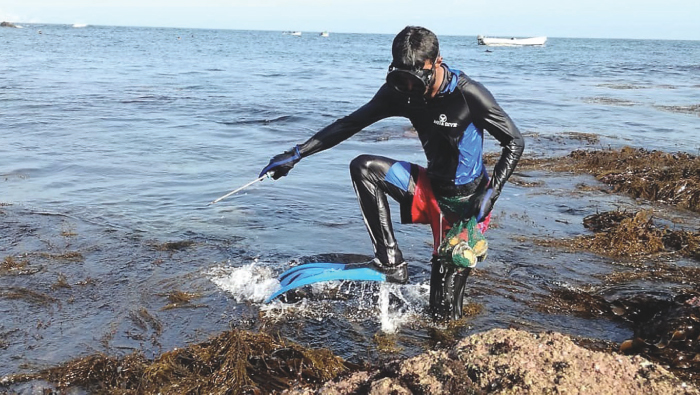
Sadah: Abalone Fishing Season has startedand it is one of the most important maritime seasons that the people of Dhofar Governorate await every year. The Dhofaris, especially those living in the Wilayats of Sadah and Mirbat, depend on it for good returns.
Abalone is a mono-shelled molluscs, which lives in coastal areas with rocky beaches where algae and seaweeds are abundant. It is one of the marine species of high economic value in global markets.
It is known in Arabic as “ear-shell” and globally as abalone. It is often glued to the lower surfaces of the rocks where it lives inside a rough-surface elliptical shell, with a row of holes at its sides that helps it to breath. It is a nocturnal creature i.e. active in the dark and less during the day.
Because of the noticeable decrease in the abalone reserve in its locations on the beaches extending from “Mirbat” to the “Sharbathat” area, the Ministry of Agriculture and Fisheries prohibited abalone fishing in some years and allowed it in some other years.
Musllam bin Salim Ra’afait, Director of the Fish Affairs Department at the Directorate General of Fisheries in the Governorate of Dhofar said, “The Ministry is making great efforts to educate fishermen in general and divers in particular, about the importance of abalone, the necessity of preserving it, and the bad consequences of erroneous fishing practices of divers to the divers, society and state in general.”
The Ministry of Agriculture and Fisheries represented by the Directorate General of Fisheries in the Governorate of Dhofar completed its preparations for the current season after the two-year ban to maintain the stock of abalone for a period of two years. All the application forms for licensing for divers and traders, as well as the records of abalone production have been prepared for distribution to traders. No new licences have been issued; rather, licences were issued to divers with previous diving licences. The number of licences for divers reached approximately 2,503 and about 94 licences for traders.
On the productivity of previous seasons, the Director of the Fish Affairs Department at the Directorate General of Fisheries in the Governorate of Dhofar told Oman News Agency: “The total production in the records of abalone traders in 2016 (12 days only) reached (54,819 tonnes).
Knife-like tool
Abalone fishermen get ready in the early morning hours throughout the season with their simple tools, which are a knife-like tool, eye glasses, and a net that is worn around the waist to collect the crop.
In the evening, they return to land and work to extract the meat of abalone from its shell by means of a sharp tool known locally as “Al jazra (the carrot) and then go to the traders’ sites to sell their daily crop of abalone according to the agreed price, usually ranging between OMR30 to OMR50 per kg, which is unfixed price that changes at the beginning of each season.
East Asian countries
The longer the drying period, the higher the quality of Abalone. Then it is canned and sold to foreign markets, especially for East Asian countries, the most important of which is Hong Kong, which is a major market for the abalone of Oman due to its quality and scarcity.
It is worth noting that abalone is considered one of the marine species with a high nutritional value, as it contains a high percentage of protein.
It is also one of the most important components of the rare marine wealth abundant in Omani waters. There are about 120 types of abalone in the seas of the world. It is mostly found, besides the Sultanate, in Japan, Australia, Mexico, New Zealand, the United States of America and South Africa.